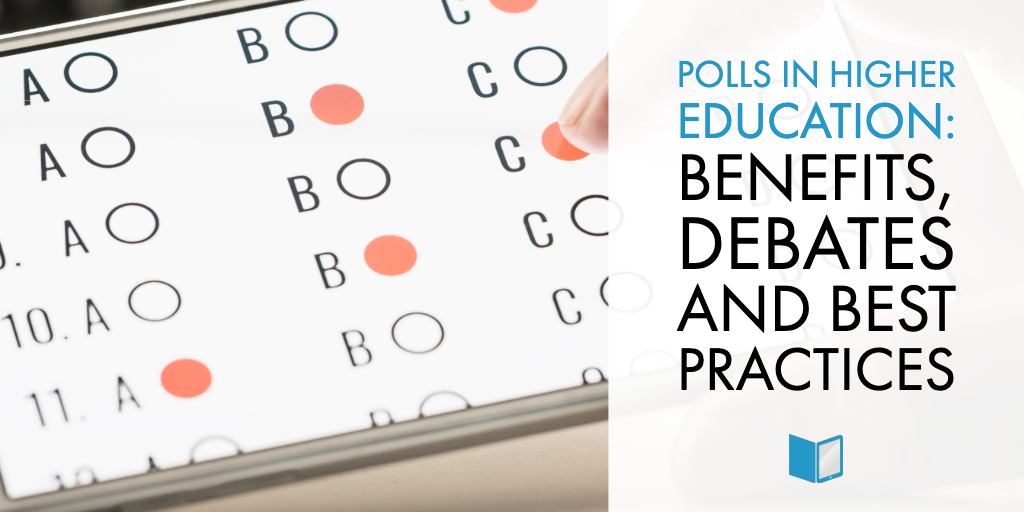Educators are constantly on the lookout for new ways to increase engagement and comprehension among their students, and tools that tap-in and measure student understanding are among the most valuable in the modern-day toolkit.
Thanks to the rise of mobile technology and BYOD, it’s easier than ever to get a real-time snapshot of what your students know (or don’t know). So what are the benefits of using polls in your classroom environment, and how can you make sure you get the most out of this interactive and engaging content type?
The Benefits of Polling
Incorporating the right performance support material into a lesson plan can be more than just a technical challenge, it can also be a lot of work. But whether you’re using clickers or digital polling methods, getting in the habit of using polls in your teaching comes with many benefits:
- Increase participation: Forget nails on a chalkboard, as one of the most terrifying sounds in any classroom is the deafening silence that comes along with “Does anyone want to volunteer an answer?” Whether it’s because they’re afraid of embarrassment or just not listening, the anonymity of polls allows every student to provide an honest answer without the fear of public humiliation. Polling increases (and sustains) student engagement in the classroom.
- Reduce learner anxiety: Introducing polls into your flipped classroom can help to break the ice for anxious students who just aren’t getting it yet. Polling helps to reduce the anxiety of sharing a wrong answer, and they can also help students gain insights about one another and build confidence in their own learning.
- Uncover learning gaps: Polls are incredibly useful when it comes to identifying any gaps in your learners’ comprehension. Using quick and simple polls in your learning content surfaces what areas of your subject matter have been understood, and which ones you may need to revisit.
- Provide feedback: Believe it or not, many students who have used polling in the classroom report that the feedback they get from polling is an important part of their own learning. Polling is the perfect way to let students test out their own knowledge and identify learning gaps on their own.
What are people saying about digital polling?
The benefits and challenges of polling in education have been debated for years. To highlight the main themes:
- Devices & internet access: Educators no longer need to rely on specific hardware like clickers to provide access to polling in the classroom. Since (almost) every student has access to a cellphone, and most campuses and nearby businesses provide access to free wifi, many institutions have started incorporating polls into their content and classrooms by way of mobile applications and SaaS platforms. This allows you to deliver your learning content literally into the hands of your students.
- Attention span: Polling helps you re-focus your students, as data shows most people cannot concentrate on something for more than 20 minutes at a time. Introducing a poll after a segment of learning material provides a welcome break, stimulates active learning and allows the learner to revisit concepts for a knowledge check.
- Collecting data: Seeing live polling results as part of an active lecture allows for real-time adaptive learning. For example, if the majority of responses to a question are incorrect, the topic(s) can be revisited immediately.
Best Practices for Introducing Polls Into Your Learning Strategy
- Identify your poll-able moments: This interactive content type works best when it’s thoughtfully executed and incorporated directly into the learning experience. Start by identifying your “poll-able” moments, like ones that stimulate conversation or quantify student understanding.
- Stimulate peer-to-peer discussion: Polling in the classroom not only gives educators a good idea as to where their students stand on core concepts, it also acts as a catalyst for valuable peer-to-peer learning opportunities. Compliment the effectiveness of introducing polls by breaking learners up into smaller groups or pairs. Ask students to discuss ideas, concepts, or opinions in order to come to a consensus and answer the questions in front of them.
- Don’t forget variety: Although the use of technology in the classroom really can spice things up, if your polls are always in the same pedagogical format, even they can become a bore. Don’t be afraid to switch things up, or even to gamify your learning experience.
- Gather (and use) your analytics: Paying attention to the analytics that come along with your polling solution does more than just provide insight into your students’ understanding or opinions. Use your analytics to evaluate, inform, and improve the strengths and clarity of your course material and questions.
No matter how you end up using digital polling in your classroom, make sure that it adds value to your experience as an educator as well as the experience of your learners.
To learn more about how MyEcontentFactory can introduce polling and generate higher levels of learner engagement, contact a member of our team today!






Leave a comment